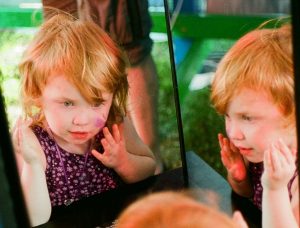Psychological Research Topics Using True Mirrors.
The True Mirror creates a number of exciting research potentials for understanding who we are and how we are, through the accurate self-reflection of our faces without reversal and in 3 dimensions. Not only do significant effects exist, but they suggest intriguing solutions to the issues that may turn out to have been caused by the traditional flat mirror.
The main effect we have noticed is that self-communication is enhanced greatly because reflected expressions match what is real. Direct eye contact with left on the left, right on the right establishes a feedback loop to oneself without information distortion, thus allowing normal communication to occur. In addition, our eyes, which create information and light we communicate with, require the 3D to focus and direct that light. Over 30,000 people have looked into the True Mirror since 1992, approximately 10-20% see and feel significant, positive differences. The other responses are equally intriguing, perhaps being correlated to different personality traits. Quantifying and qualifying the effects, determining short and long term benefits of this kind of experience, and developing practices to enhance the benefits are the goals of our research efforts.
Note: this list has been compiled by the True Mirror creator, John Walter, trained in physics and math. More formalized versions are needed to be written by a professional within each area.
Measuring the effects using EEG and Functional MRI:
Can the visual effects of those that stay animated in the true reflection mirror be quantified and qualified with brain scans, proving how vitality is lost in the traditional mirror?
Short and long term benefits of true reflection mirror usage:
How can knowledge of a “true self” be beneficial to countering some common self-image misperceptions that come from the “mirror self”, most notably being able to see our vibrant, expressive nature. Can this information assist in therapeutic counseling sessions?
Explaining the effects using Split Brain Hemisphere knowledge:
Using the ideas of right brain/left brain to illustrate how and why we perceive backwards faces differently than natural faces. Also this response to backwards faces can likewise illustrate our understanding of right brain/ left brain theory
Psychological Profile correlation with true reflection mirror response:
Our experience shows clear patterns between response and personality traits and types. Can this be quantified with standard tests and used to quickly categorize people?
Abnormal Psychology – Mirror connections?
When someone’s internal self-dialog is highly divergent from what is natural, did/does the backwards self-image have some causation? Can the information from the true reflection mirror help heal some of these issues?
Trauma:
Can the experience of seeing one’s true internal struggles with trauma help the healing process? Can seeing empathy and compassion within one’s own eyes change the dialog?
Autism:
Can the true reflection mirror help induce more interactivity in autistic children, as well as improve their connection to other people, as they see themselves more similar to others and reflections match what they are feeling?
Early Childhood and Adolescent Development:
Would children have more wholesome growth of self-understanding, especially during key phases, with daily exposure to their natural true image? Would it help to ignore the often contradictory mirror image? What are the benefits of not feeling “different” than everyone else?
Counseling work – Therapeutic and Diagnosis Insight:
Can the true reflection mirror response be used to quickly gauge areas of work that new clients need to work on? Using the true reflection mirror to clear up long held misperceptions of self and self-image?
Body Dysmorphic Disorder:
Does enabling a person to see their full self in a true reflection mirror help clear up severe body issues? Does the 3d Effect help or hurt? Managing the perceived asymmetries
Animal research:
Would more animals pass the “mirror test” if they were able to perceive more of their expressions with meaning in the true reflection mirror? Could more introspection be induced in those that already pass the mirror test? Ethical considerations?
Interesting research articles on Mirrors and Self-Understanding
Early Childhood Development
One of the most intriguing questions still to be answered is how will the presence of a True Mirror affect how children first develop a sense of self (between 6 and 18 months), along with later developments as the child grows. The hypotheses is that the communication accuracy provided by a True Mirror will significantly and positively contribute to a robust sense of self, with much more of the true nuance that the external visage represents what is happening internally. Below are some of the existing research and activities related to this critical aspect of self.
Johannes L. Brandl, The puzzle of mirror self-recognition, Phenomenology and the Cognitive Sciences, (2016).
Using mirrors in Daycare – article at BrightHubEducation.com. Imagine having True Mirrors to accomplish the same tasks listed here
Devlopment of Self Recognition in Infants BENNETT I. BERTENTHAL AND KURT W. FISCHER, University of Denver,1978,
Mirror effect
Margot Phaneuf THE MIRROR EFFECT:MEDIATOR OF KNOWLEDGE AND SELF-IMAGE
Mirror Neurons –
Mirror Neuron overview – Wikipedia article
